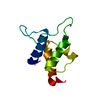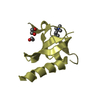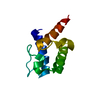[English] 日本語
 Yorodumi
Yorodumi- PDB-7pdi: Crystal structure of the holo-acyl carrier protein (holo-AcpP) fr... -
+ Open data
Open data
- Basic information
Basic information
| Entry | Database: PDB / ID: 7pdi | ||||||||||||
|---|---|---|---|---|---|---|---|---|---|---|---|---|---|
| Title | Crystal structure of the holo-acyl carrier protein (holo-AcpP) from Pseudomonas putida KT2440. Produced as an apo/holo mixture. | ||||||||||||
 Components Components | Acyl carrier protein | ||||||||||||
 Keywords Keywords | LIPID BINDING PROTEIN / phosphopantetheine / acyl-binding / fatty acid transport / holo-AcpP | ||||||||||||
| Function / homology |  Function and homology information Function and homology informationlipid A biosynthetic process / acyl binding / acyl carrier activity / cytosol Similarity search - Function | ||||||||||||
| Biological species |  Pseudomonas putida (bacteria) Pseudomonas putida (bacteria) | ||||||||||||
| Method |  X-RAY DIFFRACTION / X-RAY DIFFRACTION /  SYNCHROTRON / SYNCHROTRON /  MOLECULAR REPLACEMENT / Resolution: 1.69 Å MOLECULAR REPLACEMENT / Resolution: 1.69 Å | ||||||||||||
 Authors Authors | Venter, P. / Sewell, B.T. / Trindade, M. / Mandyoli, L. / van Zyl, L. | ||||||||||||
| Funding support |  United Kingdom, United Kingdom,  South Africa, 3items South Africa, 3items
| ||||||||||||
 Citation Citation |  Journal: To Be Published Journal: To Be PublishedTitle: Crystal structure of the holo-acyl carrier protein (holo-AcpP) from Pseudomonas putida. Produced as an apo/holo mixture. Authors: Venter, P. | ||||||||||||
| History |
|
- Structure visualization
Structure visualization
| Structure viewer | Molecule:  Molmil Molmil Jmol/JSmol Jmol/JSmol |
|---|
- Downloads & links
Downloads & links
- Download
Download
| PDBx/mmCIF format |  7pdi.cif.gz 7pdi.cif.gz | 47.2 KB | Display |  PDBx/mmCIF format PDBx/mmCIF format |
|---|---|---|---|---|
| PDB format |  pdb7pdi.ent.gz pdb7pdi.ent.gz | 31.5 KB | Display |  PDB format PDB format |
| PDBx/mmJSON format |  7pdi.json.gz 7pdi.json.gz | Tree view |  PDBx/mmJSON format PDBx/mmJSON format | |
| Others |  Other downloads Other downloads |
-Validation report
| Summary document |  7pdi_validation.pdf.gz 7pdi_validation.pdf.gz | 406.6 KB | Display |  wwPDB validaton report wwPDB validaton report |
|---|---|---|---|---|
| Full document |  7pdi_full_validation.pdf.gz 7pdi_full_validation.pdf.gz | 408.1 KB | Display | |
| Data in XML |  7pdi_validation.xml.gz 7pdi_validation.xml.gz | 6.2 KB | Display | |
| Data in CIF |  7pdi_validation.cif.gz 7pdi_validation.cif.gz | 7.3 KB | Display | |
| Arichive directory |  https://data.pdbj.org/pub/pdb/validation_reports/pd/7pdi https://data.pdbj.org/pub/pdb/validation_reports/pd/7pdi ftp://data.pdbj.org/pub/pdb/validation_reports/pd/7pdi ftp://data.pdbj.org/pub/pdb/validation_reports/pd/7pdi | HTTPS FTP |
-Related structure data
| Related structure data |  1t8kS S: Starting model for refinement |
|---|---|
| Similar structure data |
- Links
Links
- Assembly
Assembly
| Deposited unit | 
| |||||||||
|---|---|---|---|---|---|---|---|---|---|---|
| 1 |
| |||||||||
| Unit cell |
| |||||||||
| Components on special symmetry positions |
|
- Components
Components
| #1: Protein | Mass: 9340.253 Da / Num. of mol.: 1 Source method: isolated from a genetically manipulated source Details: holo-acyl carrier protein (holo-AcpP). The protein was produced and crystallized as an apo/holo-AcpP mixture and therefore has lower occupancy of the posttranslationally attached ligand ...Details: holo-acyl carrier protein (holo-AcpP). The protein was produced and crystallized as an apo/holo-AcpP mixture and therefore has lower occupancy of the posttranslationally attached ligand (phosphopantetheine (4HH)) Source: (gene. exp.)  Pseudomonas putida (strain ATCC 47054 / DSM 6125 / NCIMB 11950 / KT2440) (bacteria) Pseudomonas putida (strain ATCC 47054 / DSM 6125 / NCIMB 11950 / KT2440) (bacteria)Strain: ATCC 47054 / DSM 6125 / NCIMB 11950 / KT2440 / Gene: acpP, PP_1915 / Plasmid: pGEX-6P-2 / Production host:  |
|---|---|
| #2: Water | ChemComp-HOH / |
| Has ligand of interest | Y |
-Experimental details
-Experiment
| Experiment | Method:  X-RAY DIFFRACTION / Number of used crystals: 1 X-RAY DIFFRACTION / Number of used crystals: 1 |
|---|
- Sample preparation
Sample preparation
| Crystal | Density Matthews: 2.18 Å3/Da / Density % sol: 43.59 % |
|---|---|
| Crystal grow | Temperature: 293.15 K / Method: vapor diffusion, sitting drop Details: 20% (v/v) PEG 500 MME, 10% (w/v) PEG 20000, 0.1 M Tris Bicine buffer, pH 8.5, 0.03 M magnesium chloride hexahydrate, 0.03 M calcium chloride dihydrate |
-Data collection
| Diffraction | Mean temperature: 100 K / Serial crystal experiment: N |
|---|---|
| Diffraction source | Source:  SYNCHROTRON / Site: SYNCHROTRON / Site:  Diamond Diamond  / Beamline: I04 / Wavelength: 0.9786 Å / Beamline: I04 / Wavelength: 0.9786 Å |
| Detector | Type: DECTRIS EIGER2 X 16M / Detector: PIXEL / Date: Jan 19, 2019 |
| Radiation | Protocol: SINGLE WAVELENGTH / Monochromatic (M) / Laue (L): M / Scattering type: x-ray |
| Radiation wavelength | Wavelength: 0.9786 Å / Relative weight: 1 |
| Reflection | Resolution: 1.69→30.988 Å / Num. obs: 9120 / % possible obs: 100 % / Redundancy: 12.3 % / CC1/2: 0.9994 / Rmerge(I) obs: 0.0705 / Net I/σ(I): 14.05 |
| Reflection shell | Resolution: 1.69→1.72 Å / Redundancy: 9.7 % / Num. unique obs: 459 / CC1/2: 0.397 / % possible all: 100 |
- Processing
Processing
| Software |
| ||||||||||||||||||||||||||||||||||||||||||||||||||||||||||||||||||||||||||||||||||||||||||||||||||||||||||||||||||||||||||||||||||||||||||||||||||||||
|---|---|---|---|---|---|---|---|---|---|---|---|---|---|---|---|---|---|---|---|---|---|---|---|---|---|---|---|---|---|---|---|---|---|---|---|---|---|---|---|---|---|---|---|---|---|---|---|---|---|---|---|---|---|---|---|---|---|---|---|---|---|---|---|---|---|---|---|---|---|---|---|---|---|---|---|---|---|---|---|---|---|---|---|---|---|---|---|---|---|---|---|---|---|---|---|---|---|---|---|---|---|---|---|---|---|---|---|---|---|---|---|---|---|---|---|---|---|---|---|---|---|---|---|---|---|---|---|---|---|---|---|---|---|---|---|---|---|---|---|---|---|---|---|---|---|---|---|---|---|---|---|
| Refinement | Method to determine structure:  MOLECULAR REPLACEMENT MOLECULAR REPLACEMENTStarting model: 1T8K Resolution: 1.69→30.988 Å / Cor.coef. Fo:Fc: 0.968 / Cor.coef. Fo:Fc free: 0.956 / WRfactor Rfree: 0.232 / WRfactor Rwork: 0.189 / SU B: 4.768 / SU ML: 0.136 / Average fsc free: 0.7495 / Average fsc work: 0.7582 / Cross valid method: THROUGHOUT / ESU R: 0.127 / ESU R Free: 0.124 Details: Hydrogens have been added in their riding positions
| ||||||||||||||||||||||||||||||||||||||||||||||||||||||||||||||||||||||||||||||||||||||||||||||||||||||||||||||||||||||||||||||||||||||||||||||||||||||
| Solvent computation | Ion probe radii: 0.8 Å / Shrinkage radii: 0.8 Å / VDW probe radii: 1.2 Å / Solvent model: MASK BULK SOLVENT | ||||||||||||||||||||||||||||||||||||||||||||||||||||||||||||||||||||||||||||||||||||||||||||||||||||||||||||||||||||||||||||||||||||||||||||||||||||||
| Displacement parameters | Biso mean: 44.778 Å2
| ||||||||||||||||||||||||||||||||||||||||||||||||||||||||||||||||||||||||||||||||||||||||||||||||||||||||||||||||||||||||||||||||||||||||||||||||||||||
| Refinement step | Cycle: LAST / Resolution: 1.69→30.988 Å
| ||||||||||||||||||||||||||||||||||||||||||||||||||||||||||||||||||||||||||||||||||||||||||||||||||||||||||||||||||||||||||||||||||||||||||||||||||||||
| Refine LS restraints |
| ||||||||||||||||||||||||||||||||||||||||||||||||||||||||||||||||||||||||||||||||||||||||||||||||||||||||||||||||||||||||||||||||||||||||||||||||||||||
| LS refinement shell |
|
 Movie
Movie Controller
Controller












 PDBj
PDBj

